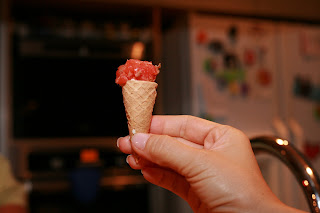









This is a food diary. I hope to document what I cook, how I cook it and how i grow as a cook. This is an evolutionary discovery and learning of good cooking using all sorts of ingredients. I will try to respect the cultures and history that these food comes from.
Its a warm saturday and what more ideal than a plate of vine ripened tomatoes, and pasta with pesto. In the era of over con-fusion and molecularized cooking (a fan..but it can be taken to the wrong level), nothing evokes great cooking than something so simple as a plate of pasta with home made pesto and a side of tomatoes.
Ingredients
handful of basil
pine nuts
one to two cloves of garlic
cup of grated parmigiano
pinch of coarse sea salt
good olive oil
Equipment
mortar and pestel
A few words on the ingredients. The basil was plucked less than 48 hours ago from down under. They smell like basil, with dirt and sun on them, not some tasteless bland looking hydroponic plant. The olive oil was Spanish, not italian..just because it tasted better than the Italian in my larder. When you cook, taste your raw ingredients if you can, this will connect you better to the food and gives you a better understanding of how each ingredient contributes to your final dish. In this case, it was the basil, olive oil, pine nuts, coarse salt and cheese.. each component tasted great by itself.
A note on the equipment, use this! Don't use a food processor or a blender. The blades chops the basil very fine but it will not release the basil's maximum flavour nor aroma. The cutting motion of the blades in a food processor closes or blocks the veins of the basil, the heat produced by the rapid rotation of the blades causes the delicate oils to evaporate as well.
Now for the assembly. Take one clove of garlic, skin and trim the end, lightly smash it in your mortar. The first few pounding will break the garlic up, releasing its essence. The subsequent pounding will break it into a paste. Slowly add a few basil leaves and a pinch of the salt. The salt will act as an abrasive to the leaves, helping it break down as you slowly pound it. Keep adding leaves bit by bit until you've used them all up. Once you see the leaves all broken down, rotate your pestel around the mortar, this will smear the leaves and the garlic, giving you a nicer consistency. Throw in about two teaspoons of pine nuts (If you want a nuttier taste, add more. If you want a richer flavour, gently toss them in a dry warm pan to give it some colour). Pound and rotate until you get a nice consistency from all the ingredients. Add a quarter cup of olive oil and use the pestel to incorporate the ingredients. If you find it too thick, add a bit more olive oil. Then finally, add in your grated parmesan. The parmesan will absorb some of the olive oil at this stage. Keep incorporating the cheese and the other ingredients together and adjust the olive oil as necessary. It is adviced that you may use some of the pasta water to thin the mixture. I prefer to keep a thicker paste and thin the mixture when i'm tossing it with pasta.
Application
Box of Barilla #5's (or whichever you prefer)
Coarse Salt
Plenty of water
Boil plenty of water for your pasta, throw in your salt, about a tablespoon worth. When you get a nice boil, put in the desired amount of dry pasta in. Use a pair of kitchen tongs to coerce them pasta in the water. Follow the timing instructions on the box, #5 pasta literally cooks in 5 minutes. Stir the pasta to prevent from sticking. The oil in pasta water gig just don't work.
Drain pasta, place in a wide bowl, throw in a couple of tablespoons of pesto and toss the whole thing together. If its too pasty, use some of the pasta water to thin it. A few twists on the pepper grinder, and you have heaven on a plate!




















